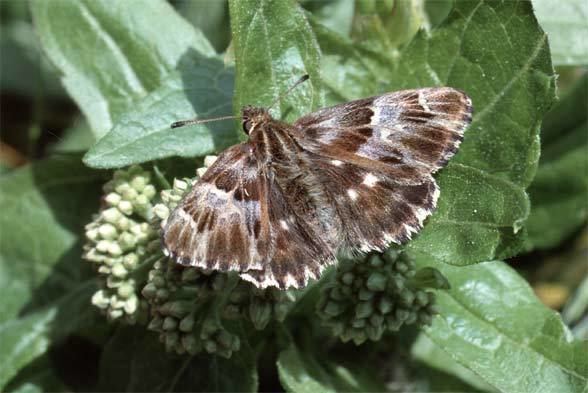Kingdom Animalia Class Insecta Family Hesperiidae Scientific name Carcharodus flocciferus | Phylum Arthropoda Order Lepidoptera Genus Carcharodus Rank Species | |
 | ||
Similar Carcharodus, Carcharodus lavatherae, Butterflies and moths, Olive skipper, Carcharodus alceae | ||
Carcharodus flocciferus, the tufted skipper or tufted marbled skipper, is a butterfly of the family Hesperiidae.
Contents
Distribution
This principally mountain species can be found in Spain, France, Italy, the Alps and the Balkans, from southern and central Europe, north to central Germany and east to Macedonia and Bulgaria. It is also found in peninsular Italy, in Portugal, Corsica, Sardinia and uncommonly in northern and western France. It is not present in the United Kingdom. The species usually inhabits the sunny edges and glades of forests, and damper areas with grasses and meadows.
Description
Carcharodus flocciferus has a wingspan of 32–35 millimetres (1.3–1.4 in). The basic color of the forewings is marbled gray-brown, with dark brown and clearer markings. The underside of the front wings is light gray-brown. A rusty "tuft" is present on the underside of the forewings (hence the common name of the species). On the upper side of the hind wings there are bright spots. The underside of the hindwings is rather uniform. Antennae show a black spot on the top. Both sexes bear the same wing drawings, but the female has no hair.
The dark brown eggs are flattened, with strong ribs to the upper end. The relatively compact and strongly hairy caterpillars are initially gray with a black head. Later they become somewhat brighter. The pupa is bluish with a black longitudinal stripe on the back of the thorax.
This species is quite similar to Carcharodus alceae, Carcharodus lavatherae and Carcharodus orientalis. In this species forewings are larger than in Carcharodus alceae.
Biology
Adults are on wing from May to June or July to September in two generations. At higher altitudes there is only one generation from June to August. The eggs are laid singly on the upper side of the leaves of the host plants. The larvae feed on Stachys (Stachys officinalis, Stachys recta, Stachys alpina), Marrubium (Marrubium vulgare, Marrubium peregrinum), Thymus roegneri and Ballota nigra. The larvae overwinter at the base of the plant.
